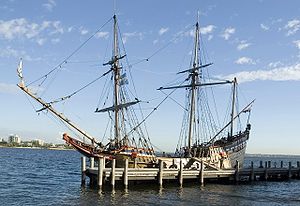Duyfken

The 1999 replica of Duyfken in 2006
|
|
| History | |
|---|---|
|
|
|
| Name: | Duyfken |
| Launched: | 1595 |
| Fate: | Condemned beyond repair July 1608 at Ternate |
| General characteristics | |
| Type: | Barque |
| Displacement: | 110 tons |
| Length: | 65.4 ft (19.9 m) |
| Beam: | 19.7 ft (6.0 m) |
| Draft: | 8 ft (2.4 m) |
| Propulsion: | Sail |
| Speed: | 7 knots (13 km/h; 8.1 mph) |
| Armament: | 8 cannons |
Duyfken (Dutch pronunciation: [ˈdœyfkən]; Little Dove), also spelled Duifken or Duijfken, was a small ship built in the Dutch Republic. She was a fast, lightly armed ship probably intended for shallow water, small valuable cargoes, bringing messages, sending provisions, or privateering. The tonnage of Duyfken has been given as 25-30 lasten (50-60 tons).
In 1606, during a voyage of discovery from Bantam (Banten), Java, captained by Willem Janszoon, she encountered the Australian mainland. Janszoon is credited with the first authenticated European discovery of Australia. In 1608, the ship was damaged beyond repair.
A reproduction of Duyfken was built in Australia and launched in 1999.
In 1596, a ship named Duyfken sailed in the first expedition to Bantam, the crew was captured by the islanders on Pulau Enggano. On 23 April 1601, Duyfken sailed from Texel as the jacht, or scout, under skipper Willem Cornelisz Schouten to the Spice Islands. After reaching Bantam, the "Moluccan Fleet", consisting of five ships including the Duyfken under admiral Wolphert Harmensz, encountered a blockading fleet of Portuguese ships totalling eight galleons and twenty-two galleys. They engaged this fleet in intermittent battle, driving them away on New Year's Day 1602. Thus, the undisputed dominance of the Iberians (Portuguese and Spanish) in the spice trade to Europe was ended.
The fleet received a warm welcome in Bantam, repairs were carried out to damage caused in the battle, and a survey of Jakarta Bay was undertaken, where the Dutch would later build Batavia, their capital in the Indies. Then, sailing by way of Tuban, East Java to the Spice Island of Ternate, cloves were loaded on board and the ship returned to Banda for a cargo of nutmeg.
...
Wikipedia
